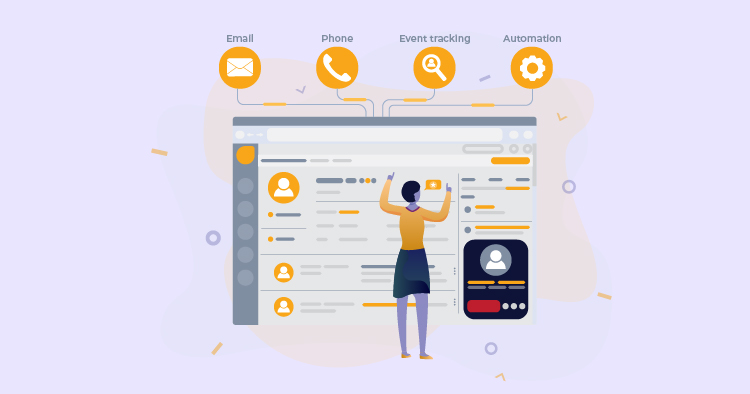Understanding the distinction between a sales funnel and a pipeline is crucial when managing customer relationships and driving sales. Both concepts are fundamental in guiding potential customers to become loyal patrons. However, they serve different purposes and offer unique insights into the sales process. This article will delve into the nuances of each term, clarifying how each term contributes to a business’s success and emphasizing that companies should not use them interchangeably. By exploring their characteristics and applications, we aim to provide a clear perspective on how each tool can optimize your sales strategy.
What is a Sales Funnel and Pipeline?
Think of a sales funnel as a map of a customer’s journey from first hearing about a product to buying it. Imagine a natural funnel, wide at the top and narrow at the bottom. At the top, many potential customers become aware of a product or service. As they learn more and think it over, some lose interest, and the number of potential buyers decreases. Finally, at the narrow end of the funnel, a few decide to purchase.
A sales pipeline, though, is like a track for potential sales. Companies use it to see where a potential sale stands in the process of becoming an actual sale. It’s like having a series of buckets representing different stages of the sale process. Each bucket holds opportunities at that stage, and as the sale moves forward, it’s transferred to the next bucket. This way, companies can see how many potential sales are at each stage and manage them more effectively.
The Role of a Sales Funnel
The sales funnel is all about turning strangers into customers. It’s a guide that helps businesses understand what their potential customers think and do at each buying process step. By knowing this, companies can create the right messages and offers to attract and keep their interest. For example, people discover what’s for sale at the awareness stage. Here, businesses might use ads or social media to get their attention.
As potential customers get curious and move to the interest stage, businesses might provide more information, like helpful blog posts or newsletters, to keep them engaged. Then, when potential customers think about buying and reach the decision stage, businesses might offer a demo or a trial to help them decide. Finally, at the action stage, the company allows the customer to say yes and complete the purchase.
Exploring the Role of a Sales Pipeline
A sales pipeline acts like a roadmap for sales teams. It allows them to monitor potential deals through various sales process stages. This visibility is critical because it helps teams determine how to use their time and resources wisely and predict future sales.
Imagine a sales pipeline as a series of checkpoints. First, the team finds people who might want to buy what they’re selling—this is prospecting. Next, they ensure these potential customers are a good fit—that’s qualification. After that, they present their product or service in the best light—the proposal stage. Finally, they aim to seal the deal, aptly named the closing stage.
Critical Differences Between Sales Funnel and Pipeline
Sales funnels and pipelines might seem similar, but they have different focuses. A sales funnel is all about the buyer’s experience. It maps out a customer’s steps from learning about a product to purchasing. It’s a tool for understanding and shaping how customers decide to buy.
Struggling with Digital marketing? Book Your Free Strategy Session!
- 30-Minutes Session
- Expert Insights
- Data-Driven approach
- Optimized Strategies for Your Goals
On the other hand, a sales pipeline is about the seller’s process. It’s a practical tool for sales teams to track where each potential sale is and what needs to happen next. It’s less about the buyer’s psychology and more about the seller’s strategy and actions.
Essentially, the sales funnel is customer-centric, while the sales pipeline is sales-centric. Both are valuable, but they serve different purposes in sales.
Sales Funnel vs. Sales Pipeline: The Customer Perspective
When customers consider a product or service, they embark on a journey that begins with awareness and ideally ends with a purchase. This journey is what we call the sales funnel. It visualizes customers’ gradual process, from first hearing about something to deciding it’s the right choice for them. The funnel helps businesses understand how to reach customers at every step, offering the correct information and support to influence their decisions.
On the flip side, the sales pipeline is like a behind-the-scenes look at the selling process from the company’s viewpoint. It’s a practical tool that shows where potential buyers are purchasing. It’s all about the nuts and bolts of sales: following up on leads, ensuring no missed opportunities, and understanding how to push for a close at the right time.
Sales Funnel vs. Sales Pipeline: The Sales Team Perspective
For salespeople, the sales funnel isn’t just a series of steps; it’s a map of the customer’s mind. It shows the sales team what potential customers might think or need at different stages. With this knowledge, salespeople can craft their approach to match customer expectations and concerns, making it more likely to turn interest into a sale.
The pipeline is a crucial organizational tool from the sales team’s angle. It’s where they can see all their potential deals and understand which ones need attention. This clarity helps the team stay focused and prioritize their efforts. They can see who’s ready to buy, who might need more convincing, and where to concentrate their energy to meet their sales targets.
Aligning Sales Funnel and Pipeline for Maximum Success
When running a small business, it’s essential to ensure that your sales funnel and pipeline work together like a well-oiled machine. This means attracting and handling potential customers and matching how you sell to them. When these two things sync up, you’re more likely to deal effectively and get more customers to say “yes” to your products or services.
To get your sales funnel and pipeline on the same page, you should:
– Keep your marketing and sales teams talking to each other. When everyone knows what’s going on, staying on track is more accessible.
Struggling with Digital marketing? Book Your Free Strategy Session!
- 30-Minutes Session
- Expert Insights
- Data-Driven approach
- Optimized Strategies for Your Goals
– Use customer relationship management (CRM) tools to keep your data organized and up-to-date. This way, you can see what’s happening at every stage of the sales process.
– Regularly check in on how your customers are experiencing the buying process and how your sales team works. Look for ways to improve and keep improving.
By focusing on these steps, you can ensure that your sales efforts are as effective as possible.
Common Challenges in Implementing Sales Funnel and Pipeline
Small business owners often encounter roadblocks when setting up and using a sales funnel and pipeline. You might not have many people or money to throw at the problem or be unsure how to get your sales and marketing efforts together. These issues can make it challenging to manage your sales process and get the best results.
But don’t worry; there are ways to tackle these challenges:
– Invest time in teaching your team so they have the skills they need to succeed.
– Look into automated tools that can help you do more with less effort. This can be a game-changer for small businesses.
– Make sure your sales and marketing teams are communicating. Your strategy is more likely to work when everyone is on the same page.
– Start simple. Don’t try to do too much at once. Begin with a straightforward strategy and add more layers as you and your team get better at managing it.
By taking these steps, you can smooth out the bumps and get your sales funnel and pipeline to where they help your business grow.
Sales Funnel and Pipeline Metrics: Measuring Success
Understanding how well your sales process turns potential customers into actual buyers is crucial. You can track this by looking at conversion rates, which tell you the percentage of prospects moving to your funnel’s next stage. For example, if you start with 100 prospects and 10 of them make a purchase, your conversion rate is 10%.
Another significant number is the cost of acquiring a lead. This tells you how much you’re spending to attract each potential customer. You’ll need to rethink your strategy if it costs more to get a customer than they spend on your product.
Don’t forget about the customer’s lifetime value (CLV). The customer lifetime value (CLV) represents the total money a customer is expected to spend on your products during their relationship with your company. A high CLV means you’re excellently keeping customers and getting them back.
Regarding your sales pipeline, you’ll want to monitor the number of potential deals at each stage. This will give you a clear picture of your upcoming work and potential sales. Tracking the average time to close a deal is also helpful. If it’s taking too long, you might need to speed up your process.
Finally, your win rate is the percentage of deals you close. A high win rate means your sales team is effective, while a low rate could point to problems in your sales process or approach.
Tools and Technologies for Sales Funnel and Pipeline Management
A wealth of tools exists to help manage your sales funnel and pipeline. Customer Relationship Management (CRM) systems are a big part of this. They keep track of your interactions with current and potential customers, helping you to understand their needs and behaviors.
Marketing automation tools can handle repetitive tasks, like sending emails or posting on social media. This frees your team to focus on more complex tasks, like closing deals.
Analytics platforms are the secret weapon for understanding your sales data. They can show you patterns and trends you might overlook otherwise, helping you make smarter decisions about where to focus your efforts.
For small businesses, these technologies can be game-changers. They save time by automating tasks, giving more profound insights into what customers want, and allowing for more targeted and personalized marketing and sales activities. This can lead to better customer relationships and, ultimately, more sales.
Sales Funnel vs. Pipeline: Insights from the Pros
Drawing on the knowledge of industry experts can enrich the conversation around sales funnels and pipelines. These seasoned professionals offer a wealth of experience and can provide insights that add credibility and depth to the topic.
For example, a sales consultant with years of experience might explain the importance of distinguishing between a sales funnel and a pipeline. They could share that a sales funnel is all about a customer’s journey, from being aware of a product to making a purchase. On the other hand, it is essential to note that a sales pipeline emphasizes the progression of sales stages from an internal perspective.
These experts can also offer actionable advice, such as how to move leads through a sales funnel effectively or to keep a sales pipeline flowing smoothly. Such guidance is invaluable for small businesses aiming to enhance their sales operations and can significantly improve their overall performance.
Common Misconceptions and Myths about Sales Funnel and Pipeline
Many people confuse sales funnels and pipelines, mixing them up or thinking they’re the same thing. A sales funnel is about the buyer’s journey, from the first time they learn about your product to when they make a purchase. On the other hand, a pipeline is centered around the sales process and the actions taken by the sales team to finalize a deal.
One big myth is that setting up a sales funnel or pipeline is easy. The truth is that it takes careful planning and a good understanding of your customers. Another misunderstanding is that once you build a sales funnel or pipeline, it’ll work like magic without any more effort. In reality, you need to monitor it and make adjustments as your business and customers change.
Understanding these tools can make a difference for small business owners. It helps you guide potential customers smoothly, from learning about your product to buying it while keeping your sales team organized and focused on the right tasks.
Implementing Sales Funnel and Pipeline Strategies
Knowing how to use sales funnels and pipelines can give you a significant advantage when running a small business. Here are some key points to remember:
– Always keep your customer in mind. Your sales funnel should reflect their journey, from becoming aware of your product to buying it.
– Stay organized. Your sales pipeline is a way to track progress and make sure your sales team knows what to focus on. Ensure each stage is precise and you plan to move deals forward.
– Keep improving. The market and your customers’ needs can change, so your sales strategies should change, too. Look at your sales funnel and pipeline regularly to see what’s working and what isn’t, and be ready to make changes.
– Learn as you go. Running a business means constantly gathering new information. Use what you learn to improve your sales processes.
By focusing on these best practices, small business owners can create effective sales funnels and pipelines that help them convert more leads into customers and grow their businesses. Remember, it’s all about understanding your customers, staying organized, being willing to adapt, and using what you learn to get better.
Final Thoughts
The concepts of sales funnel and pipeline help to shape an effective sales strategy, but they cater to different aspects of the customer acquisition process. Recognizing the unique functions and benefits of each can significantly enhance a company’s approach to converting leads into customers. As businesses refine their sales tactics, the importance of distinguishing between these two tools becomes ever more apparent. Organizations can streamline their sales processes, improve forecasting, and ultimately boost their bottom line with a deeper understanding of sales funnels and pipelines.



